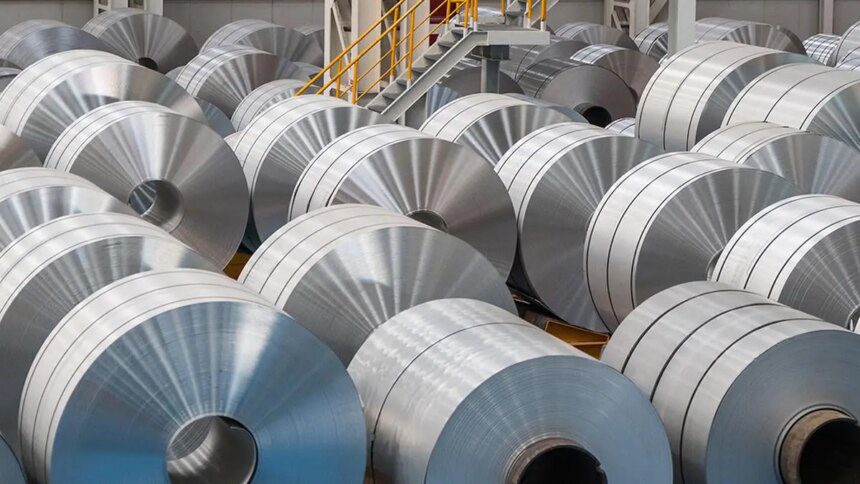Aluminium prices are expected to remain high through the end of 2025, largely driven by a weakening dollar and stable demand from China, the largest aluminium consumer worldwide, according to analysts.
On Tuesday, aluminium prices surged to a three-year high of over $2,700 per tonne, with a slight decline noted in early trading on Wednesday on the London Metal Exchange (LME). By 1715 hours IST, the price settled at $2,687.75 per tonne.
“Despite ongoing geopolitical risks, sluggish global demand prospects, and tariff obstacles presenting potential downsides, attention is shifting toward US policy expectations, a softer dollar, and stable Chinese demand, suggesting upside potential,” said BMI, a research agency under Fitch Solutions.
Price Forecast
ING Think, the economic and financial analysis division of the Dutch multinational services firm ING, reported that LME aluminium prices extended their upward trend for the eighth consecutive session on Tuesday, marking the highest closing level since February 20, 2025. This rally was fueled by expectations of a US Federal Reserve rate cut and a weaker dollar index—the lowest since 2022.
The aluminium tom-next spread (the cost of rolling positions overnight) traded at a premium of $13.25 per tonne, the highest since August 2024, indicating rising physical demand and tightening LME inventories after weeks in contango (where spot prices are lower than future contracts).
BMI has maintained its aluminium price forecast at an annual average of $2,580 per tonne. The prices have shown resilience in 2025, up more than six percent year-to-date. The Australian Office of the Chief Economist (AOCE) predicts continued pricing and demand volatility throughout 2025, attributing fluctuations to trade actions and retaliatory measures, with an average forecasted LME aluminium spot price of approximately $2,475 per tonne.
Bullish Bets Increase
The research agency noted that macroeconomic tailwinds and stronger-than-expected supply-demand fundamentals will support aluminium prices, despite the introduction of newly imposed US tariffs and geopolitical uncertainties. Recent LME data indicate a decrease in aluminium exchange stocks by 1,500 tonnes to 483,375 tonnes, while on-warrant inventories remain low at 375,025 tonnes—marking the lowest level since July 8, 2025.
According to the latest COTR report, net bullish bets in aluminium increased by 4,562 lots for the fourth consecutive week, bringing the total to 131,922 lots for the week ending September 13, the most bullish sentiment recorded since June 7, 2024.
BMI suggests that risks to its forecast remain broadly balanced but slightly skewed to the upside. “Supply-side issues in the raw materials market may also support prices, particularly ongoing resource nationalism risks in Guinea,” it noted.
New Demand Trends
BMI anticipates further U.S. dollar weakness, which has declined 10.6 percent year-to-date, will remain a significant factor supporting aluminium prices in the coming months. Markets are currently pricing in at least a 25-basis-point rate cut by the Federal Reserve this September, driven by weak employment data and Chairman Powell’s recent comments at the Jackson Hole Symposium that raised concerns regarding slower-than-expected U.S. growth.
The AOCE adds that the increasing global demand for energy-efficient vehicles and technologies will boost aluminium usage, keeping stocks relatively low. It forecasts that the free on board (FOB) Western Australia alumina price will drop from $492 per tonne in 2024 to $365 per tonne by 2027.
BMI has revised its forecast for China’s aluminium demand growth in 2025, increasing it to 1.5 percent (up from a previous estimate of 0.5 percent), anticipating that Chinese demand will help stabilize prices. Although the growth may not mirror the rapid pace of the past decade due to ongoing weaknesses in the property sector and additional external pressures, this support is crucial.
Supply-Side Challenges
The agency has also noted a likely uptick in demand in China amid geopolitical uncertainties, fueled by the growth of the clean energy sector, including solar, wind, and electric vehicles (EVs). “Given aluminium’s extensive application in these areas, we expect steady end-use demand in 2025, helping to support prices and mitigate downside risks,” BMI stated.
However, supply-side challenges could place upward pressure on prices. Notably, Guinea’s revocation of Emirates Global Aluminium’s bauxite mining license in early August presents potential constraints on global bauxite supplies.
On the demand front, weaker prospects outside of China are expected to limit price increases, particularly in the U.S. Persistent macroeconomic uncertainties and fluctuating policies from former President Trump may pose significant downside risks to aluminium price forecasts in the coming months.
Published on September 18, 2025.










